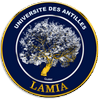Article 1. Structuring of the research unit
The Computer Science and Applications Mathematics Laboratory (LAMIA) is a research team & nbsp; intern at the University of the West Indies. It was created in 2010 as a reception team labeled EA4540.
LAMIA is headed by a director, whose mandate ends with the university's five-year contract, assisted by two deputy directors (one representing mathematics and the other computing) whose mandates end with the university's five-year contract.
LAMIA has a laboratory council made up of 10 members:
- The director and the two deputy directors as ex officio members;
- Two representatives appointed within the college of university professors;
- A representative designated within the college of senior lecturers authorized to supervise research;
- Two representatives appointed within the college of senior lecturers (not HDR);
- Two representatives appointed within the college of doctoral students registered with LAMIA;
- The board may decide to appoint, for the sake of better representativeness, an additional member thus bringing the number of members of the laboratory board to 11.
The powers of the laboratory council are presented in article 4 of these statutes.
The research carried out within LAMIA is organized within several thematic groups bringing together the core of LAMIA's skills and their applications.
Article 2. Composition of LAMIA
LAMIA welcomes permanent members, associate members and doctoral students.
Permanent members:
- Teacher-researchers whose laboratory council has validated the request for attachment to LAMIA as their main activity when submitting the laboratory renewal file;
- Teacher-researchers whose appointment to the university specifies attachment to LAMIA;
- Administrative, technical, worker and service personnel (ATOS) or technical research and training engineers (ITRF) assigned to the laboratory;
Associate Members:
Associate members are appointed after consultation with the laboratory council and by decision of the director following a written request made by the applicants to the director of the laboratory. They are recruited in particular from:
- ATERs, PASTs recruited by the university wishing to join the laboratory;
- Teacher-researchers attached mainly to another laboratory;
- Doctors who have defended their thesis in the laboratory;
- Teacher-researchers who do not justify a research activity deemed sufficient but have recognized expertise;
- Non-doctorate teachers;
- Personalities whose scientific quality is recognized;
Article 3. Election of members of the laboratory council
The elected members of the laboratory council are seven in number, chosen from among the permanent members and doctoral students, they are divided into four colleges: the college of university professors, the college of lecturers authorized to supervise research, the college lecturers and the college of doctoral students.
The election of the members of the laboratory council is carried out separately in each college. The permanent members of the colleges of university professors and lecturers, as well as the members of the college of doctoral students vote for at most two candidates. The two candidates having obtained the most votes in each college are elected. The permanent members of the college of lecturers authorized to supervise research vote at most for one candidate. When it comes to the renewal of a single seat in a college, the members of the college concerned vote for at most one candidate.
Article 4. Competences of the laboratory council
The laboratory council is chaired by the director of LAMIA or by one of his deputies if the director is unable to attend. The board meets at least twice per academic year.
The laboratory council in training restricted to teacher-researchers decides on the admission of new members; it also rules on the exclusion of members of the laboratory when they have harmed the interests of the laboratory, its stability or its image.
The laboratory council in training restricted to teacher-researchers decides on the research profile assigned to the positions of teacher-researchers who are backed by LAMIA. When it comes to job profiles of university professors, the council meets in training restricted to university professors.
The laboratory council can be consulted by the laboratory director on any question concerning the laboratory, in particular on:
- the state, the program, the coordination of research within the laboratory;
- the budgetary resources to be requested and the distribution of those allocated to it;
- the policy of research contracts concerning the laboratory;
- all relative measures to the organization and operation of the laboratory and likely to have consequences on the situation and working conditions of staff.
Article 5. Election of the director and deputy directors of LAMIA
The director of LAMIA is elected by simple majority by the permanent members of LAMIA. The election is held by secret ballot. His mandate is renewable.
The two deputy directors are each elected by a simple majority by the permanent members of LAMIA. Their election is held by secret ballot. Their mandates are renewable.
Article 6. Competences of the director and deputy directors
The director represents the laboratory.
He chairs general assemblies and meetings of the laboratory council. He is responsible for managing the financial resources of the laboratory and checks the transmission slips and invoices. He gives his visa for all research contracts carried out in the laboratory. He chairs general assemblies and meetings of the laboratory council. He is responsible for managing the financial resources of the laboratory and checks the transmission slips and invoices. He gives his visa for all research contracts carried out in the laboratory.
One of the two deputy directors is appointed by the director to act in place of the latter in his absence. Day-to-day management tasks (laboratory communication, participation in boards, contacts with outside institutions, etc.) are shared between the director and the deputy directors.
Article 7. Rules of procedure
Internal regulations define, as far as necessary, the operating rules of the laboratory.
